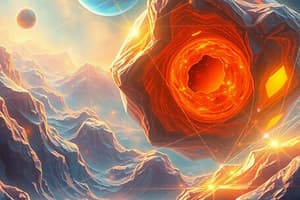Podcast
Questions and Answers
Which type of force refers to the attractions between molecules, controlling physical properties such as boiling and melting points, vapor pressures, and viscosities?
Which type of force refers to the attractions between molecules, controlling physical properties such as boiling and melting points, vapor pressures, and viscosities?
- Hydrogen bonding
- London dispersion forces
- Ion-dipole interactions
- Van der Waals forces (correct)
What type of interactions are responsible for the attraction between molecules that have permanent dipoles, with the positive end of one molecule attracted to the negative end of the other and vice versa?
What type of interactions are responsible for the attraction between molecules that have permanent dipoles, with the positive end of one molecule attracted to the negative end of the other and vice versa?
- Ion-dipole interactions
- London dispersion forces
- Dipole-dipole interactions (correct)
- Hydrogen bonding
Which type of force is an important force in solutions of ions, allowing ionic substances to dissolve in polar solvents?
Which type of force is an important force in solutions of ions, allowing ionic substances to dissolve in polar solvents?
- Dipole-dipole interactions
- London dispersion forces
- Ion-dipole interactions (correct)
- Hydrogen bonding
What type of force is responsible for attracting molecules that have permanent dipoles to each other?
What type of force is responsible for attracting molecules that have permanent dipoles to each other?
Which type of force increases with the polarity of the molecule, resulting in a higher boiling point?
Which type of force increases with the polarity of the molecule, resulting in a higher boiling point?
What is the mathematical expression for Gay-Lussac’s Law, assuming volume remains constant?
What is the mathematical expression for Gay-Lussac’s Law, assuming volume remains constant?
What type of device is used to measure the difference in pressure between atmospheric pressure and that of a gas in a vessel?
What type of device is used to measure the difference in pressure between atmospheric pressure and that of a gas in a vessel?
What causes your ears to ‘pop’ in an airplane?
What causes your ears to ‘pop’ in an airplane?
What is the weight of air per unit of area known as?
What is the weight of air per unit of area known as?
The pressure of a gas is measured as 2.5 atm. Represent this pressure in both torr and pascals.
The pressure of a gas is measured as 2.5 atm. Represent this pressure in both torr and pascals.
Flashcards are hidden until you start studying




